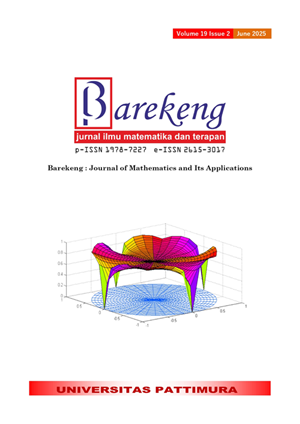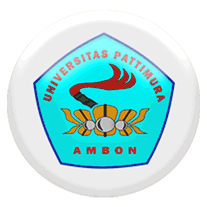FOREST FIRE ANALYSIS FROM PERSPECTIVE OF SPATIAL-TEMPORAL USING GSTAR (p;λ_1,λ_2,…,λ_p) MODEL
Abstract
West Kalimantan is particularly susceptible to the devastating effects of forest fires, among the natural disasters that have a significant impact. One of the indicators that can be used to identify forest fires is the presence of hotspots. The term "hotspot" refers to data that has both spatial and temporal characteristics. Using the Generalized Space-Time Autoregressive (GSTAR) model combined with the Queen Contiguity weight matrix, this research aims to model and forecast the confidence level of hotspots in Kubu Raya Regency and its surrounding areas. We chose the GSTAR model because of its ability to model spatial interactions between locations and temporal change patterns over time. According to NASA FIRMS, the data used in this study were confidence level hotspot data, covering the period from January 2014 to August 2024. To define locations for modeling, the study area was divided into grids measuring degrees. The maximum confidence level value in each grid was used to represent the highest potential fire risk. The research process consists of the following stages: data preparation, stationarity testing, calculation of the Queen Contiguity spatial weight matrix, identification of model orders based on STACF and STPACF plots, and estimation of model parameters to predict hotspot confidence levels. The GSTAR (3;1) model was selected as the best model because it satisfies the white-noise assumption and has a MAPE value of 14.78%. Based on the MAPE, the GSTAR (3;1) model can provide reasonably accurate predictions for the confidence level of fire points over the following three periods. The prediction results indicate a decline in the fire point confidence level across all locations during the following three periods. The findings of this study can support the optimization of resource allocation in the prevention of forest fires.
Downloads
References
N. P. Sambodo, M. Pradhan, R. Sparrow, and E. van Doorslaer, “WHEN THE SMOKE GETS IN YOUR LUNGS: SHORT-TERM EFFECTS OF INDONESIA’S 2015 FOREST FIRES ON HEALTH CARE USE,” Environmental Health, vol. 23, no. 1, p. 44, May 2024, doi: 10.1186/s12940-024-01079-x.
L. N. Adelia, I. P. Ash Shidiq, and F. Zulkarnain, “IDENTIFICATION OF FOREST FIRE HAZARD AREA IN KUBU RAYA REGENCY, WEST KALIMANTAN PROVINCE,” IOP Conf Ser Earth Environ Sci, vol. 1190, no. 1, p. 012037, Jun. 2023, doi: 10.1088/1755-1315/1190/1/012037.
T. F. Dicelebica, A. A. Akbar, and D. R. Jati, “IDENTIFIKASI DAN PENCEGAHAN DAERAH RAWAN BENCANA KEBAKARAN HUTAN DAN LAHAN GAMBUT DI KALIMANTAN BARAT,” Jurnal Ilmu Lingkungan, vol. 20, no. 1, pp. 115–126, Jan. 2022, doi: 10.14710/jil.20.1.115-126.
N. Imro, D. Kusnandar, and N. N. Debataraja, “WEST KALIMANTAN FOREST FIRE PROBABILITY MAPPING USING BINARY LOGISTIC REGRESSION,” vol. 8, no. 2, pp. 204–214, 2024.
M. Alkaff and N. E. Yulianto, “PREDIKSI JUMLAH KEJADIAN TITIK API MELALUI PENDEKATAN DERET WAKTU MENGGUNAKAN MODEL SEASONAL ARIMA,” Jurnal ELTIKOM, vol. 3, no. 2, pp. 54–63, 2019, doi: 10.31961/eltikom.v3i2.122.
N. M. Huda and N. Imro’ah, “DETERMINATION OF THE BEST WEIGHT MATRIX FOR THE GENERALIZED SPACE TIME AUTOREGRESSIVE (GSTAR) MODEL IN THE COVID-19 CASE ON JAVA ISLAND, INDONESIA,” Spat Stat, vol. 54, p. 100734, Apr. 2023, doi: 10.1016/j.spasta.2023.100734.
N. M. Huda and N. Imro’ah, “COVID-19 CASE MODELING IN JAVA ISLAND USING A SPATIAL MODEL, GSTAR(1;1), WITH MODIFIED SPATIAL WEIGHTS: QUEEN CONTIGUITY WEIGHT MATRIX,” 2024, p. 090009. doi: 10.1063/5.0201676.
Y. Widyaningsih and N. Ayu, “GENERALIZED SPATIO-TEMPORAL AUTOREGRESSIVE (GSTAR) MODELING ON CORONAVIRUS DISEASE (COVID-19) CASES IN DKI JAKARTA,” 2024, p. 030003. doi: 10.1063/5.0212710.
N. Ilmi, A. Aswi, and M. K. Aidid, “GENERALIZED SPACE TIME AUTOREGRESSIVE INTEGRATED MOVING AVERAGE (GSTARIMA) DALAM PERAMALAN DATA CURAH HUJAN DI KOTA MAKASSAR,” Inferensi, vol. 6, no. 1, p. 25, Mar. 2023, doi: 10.12962/j27213862.v6i1.14347.
U. Mukhaiyar, F. T. Nabilah, U. S. Pasaribu, and N. M. Huda, “THE SPACE-TIME AUTOREGRESSIVE MODELLING WITH TIME CORRELATED ERRORS FOR THE NUMBER OF VEHICLES IN PURBALEUNYI TOLL GATES,” J Phys Conf Ser, vol. 2243, no. 1, p. 012068, Jun. 2022, doi: 10.1088/1742-6596/2243/1/012068.
D. R. Febrianti, M. A. Tiro, and S. Sudarmin, “METODE VECTOR AUTOREGRESSIVE (VAR) DALAM MENGANALISIS PENGARUH KURS MATA UANG TERHADAP EKSPOR DAN IMPOR DI INDONESIA,” VARIANSI: Journal of Statistics and Its application on Teaching and Research, vol. 3, no. 1, p. 23, 2021, doi: 10.35580/variansiunm14645.
J. Fattah, L. Ezzine, Z. Aman, H. El Moussami, and A. Lachhab, “FORECASTING OF DEMAND USING ARIMA MODEL,” International Journal of Engineering Business Management, vol. 10, Jan. 2018, doi: 10.1177/1847979018808673.
Yundari, U. S. Pasaribu, U. Mukhaiyar, and M. N. Heriawan, “SPATIAL WEIGHT DETERMINATION OF GSTAR(1;1) MODEL BY USING KERNEL FUNCTION,” J Phys Conf Ser, vol. 1028, p. 012223, Jun. 2018, doi: 10.1088/1742-6596/1028/1/012223.
Y. Yundari, U. S. Pasaribu, and U. Mukhaiyar, “ERROR ASSUMPTIONS ON GENERALIZED STAR MODEL,” Journal of Mathematical and Fundamental Sciences, vol. 49, no. 2, p. 136, Oct. 2017, doi: 10.5614/j.math.fund.sci.2017.49.2.4.
A. Tsanawafa, D. A. Kusuma, and B. N. Ruchjana, “SPATIAL WEIGHT MATRIX COMPARISON OF SAR-X MODEL USING CASETTI APPROACH,” CAUCHY: Jurnal Matematika Murni dan Aplikasi, vol. 9, no. 1, pp. 129–137, May 2024, doi: 10.18860/ca.v9i1.25579.
M. Sobari, A. Desiyanti, D. Yanti, P. Monika, A. S. Abdullah, and B. N. Ruchjana, “COMPARISON OF SPATIAL WEIGHT MATRICES IN SPATIAL AUTOREGRESSIVE MODEL: CASE STUDY OF INTANGIBLE CULTURAL HERITAGE IN INDONESIA,” JTAM (Jurnal Teori dan Aplikasi Matematika), vol. 7, no. 1, p. 244, Jan. 2023, doi: 10.31764/jtam.v7i1.10757.
A. Schmidt et al., “FIRE FREQUENCY, INTENSITY, AND BURN SEVERITY IN KALIMANTAN’S THREATENED PEATLAND AREAS OVER TWO DECADES,” Frontiers in Forests and Global Change, vol. 7, Feb. 2024, doi: 10.3389/ffgc.2024.1221797.
A. N. Pradana, A. Djuraidah, and A. M. Soleh, “LAND USE CHANGE MODELLING USING LOGISTIC REGRESSION, RANDOM FOREST AND ADDITIVE LOGISTIC REGRESSION IN KUBU RAYA REGENCY, WEST KALIMANTAN,” Forum Geografi, vol. 37, no. 2, Dec. 2023, doi: 10.23917/forgeo.v37i2.23270.
M. S. Akbar et al., “A GENERALIZED SPACE-TIME AUTOREGRESSIVE MOVING AVERAGE (GSTARMA) MODEL FOR FORECASTING AIR POLLUTANT IN SURABAYA,” J Phys Conf Ser, vol. 1490, no. 1, p. 012022, Mar. 2020, doi: 10.1088/1742-6596/1490/1/012022.
T. C. Guetterman, “BASICS OF STATISTICS FOR PRIMARY CARE RESEARCH,” Fam Med Community Health, vol. 7, no. 2, p. e000067, Mar. 2019, doi: 10.1136/fmch-2018-000067.
U. Mukhaiyar, “THE GOODNESS OF GENERALIZED STAR IN SPATIAL DEPENDENCY OBSERVATIONS MODELING,” 2015, p. 020008. doi: 10.1063/1.4936436.
A. Roza, E. S. Violita, and S. Aktivani, “STUDY OF INFLATION USING STATIONARY TEST WITH AUGMENTED DICKEY FULLER & PHILLIPS-PERON UNIT ROOT TEST (CASE IN BUKITTINGGI CITY INFLATION FOR 2014-2019),” EKSAKTA: BERKALA ILMIAH BIDANG MIPA, vol. 23, no. 02, pp. 106–116, Jun. 2022, doi: 10.24036/eksakta/vol23-iss02/303.
A. B. Salsabila, B. N. Ruchjana, and A. S. Abdullah, “DEVELOPMENT OF THE GSTARIMA(1,1,1) MODEL ORDER FOR CLIMATE DATA FORECASTING,” International Journal of Data and Network Science, vol. 8, no. 2, pp. 773–788, 2024, doi: 10.5267/j.ijdns.2024.1.001.
Copyright (c) 2025 Hesty Pratiwi, Nurfitri Imro'ah, Nur'ainul Miftahul Huda

This work is licensed under a Creative Commons Attribution-ShareAlike 4.0 International License.
Authors who publish with this Journal agree to the following terms:
- Author retain copyright and grant the journal right of first publication with the work simultaneously licensed under a creative commons attribution license that allow others to share the work within an acknowledgement of the work’s authorship and initial publication of this journal.
- Authors are able to enter into separate, additional contractual arrangement for the non-exclusive distribution of the journal’s published version of the work (e.g. acknowledgement of its initial publication in this journal).
- Authors are permitted and encouraged to post their work online (e.g. in institutional repositories or on their websites) prior to and during the submission process, as it can lead to productive exchanges, as well as earlier and greater citation of published works.






1.gif)



